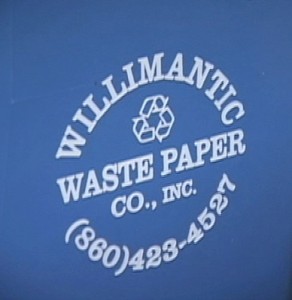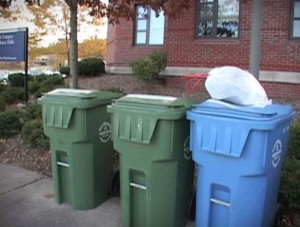Wondering which recycling bin to toss your soda can into? How about that day-old Daily Campus on your desk? Well, forget about it. At UConn, it doesn’t matter anymore.
Following the lead of Willimantic Waste, UConn’s trash hauler, the University has embraced single stream recycling, a program that allows users to throw all types of recycling materials – paper, plastic, glass, and aluminum – into a single container. The material is then trucked to a Willimantic Waste transfer station, a facility where large blowers, magnets, and other equipment sort the various products.

“The primary upside of single stream recycling is that it increases participation because it’s easier,” says Jennifer Weymouth, UConn’s sustainability coordinator in the Office of Environmental Policy. “It streamlines the infrastructure, and it’s easier to communicate how and where to recycle.”
Weymouth says many recycling service providers are moving to single stream, and by getting on board now UConn is getting a head start.
Currently, UConn faculty, staff and students recycle only about 20 percent of the disposable materials they use every day, a number Weymouth says is “disappointing.” The state has set a goal for all state agencies of 58 percent by 2024, more than a decade away but, Weymouth says, not that long, considering the University must undergo a culture change.
“We have to educate and inform and make people care about the actions they take. Reinforce positive behaviors. Not use as many disposable goods, buy in bulk to reduce packaging. There are plenty of recycling bins on campus, people just have to start using them,” she says.
Since moving to single stream, UConn has purchased 100 outdoor recycling bins that are scattered across campus, all coupled with matching black metal trash cans. The coupling is a strategic choice to ensure that recycling is at least as convenient as throwing something away. The green metal bins accept all forms of recycling – paper, aluminum, plastics, and glass. The indoor recycling bins, some of which are blue with slotted openings to accept mixed paper, and others that are green with round openings for bottles and cans, may now each be used for any recyclable material. Replacing them with one new single stream container would be costly, and the restricted openings still work to prevent people from disposing trash with recyclables.

Critics of single stream recycling say the process invites people to be less careful, and put trash and other contaminants with the recycled material. That would be a problem, because even under the single stream system, a bin full of recyclables that is heavily commingled with trash will likely be handled as garbage and hauled to the regional waste incinerator, rather than sorted for recycling at Willimantic Waste’s newly equipped transfer station. They also say processing equipment isn’t yet sophisticated, and different weight plastics may wind up mingling, leading to degradation of the recycled content end product, which then become less marketable.
But that, too, says Weymouth, requires education, which is an ongoing challenge because of the transient nature of the University. For example, many may not be aware that recycling is picked up once each week, typically on Wednesdays, while most trash is picked up on other days. And that custodial staff are trained that it’s okay to mix different kinds of recyclable materials together.
“We have to make people care about the actions they take,” Weymouth says. “We all need to be concerned citizens and environmental stewards. And in these tight budget times it also pays to recycle – the University receives rebates from Willimantic Waste for recycled materials. If nothing else, hopefully that will catch people’s attention.”


